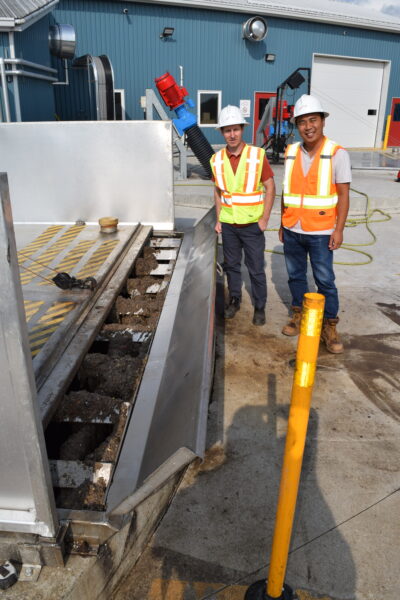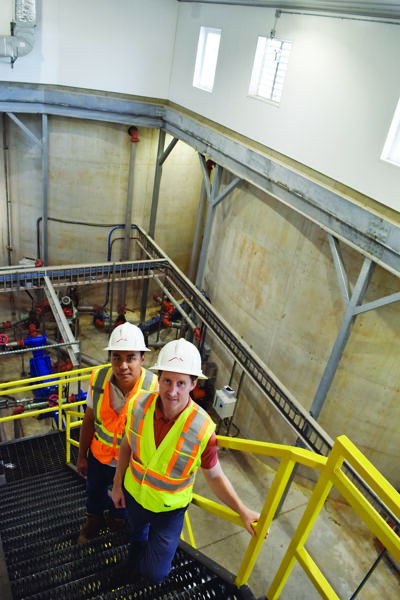
By Mike Williscraft
NewsNow
When Miller Waste purchased the Sobye Road biodigester from the Town of Grimsby in October 2019, company officials knew they had some work ahead of them not just to get the facility up to basic safety and operating standards.
Issues with core equipment, system design, site drainage, landscape standards and more were all part of what went into an 18-month, multi-million dollar overhaul to get the facility running as the project’s management team hoped.
“From the gate at the road we installed, we redid the berms along the road making them higher, added trees and a new fence, all which were part of the MoE’s (Ministry of the Environment) requirements. We also added armour stone, landscaping paving,” said site general manager Sam Huang.
“The entire site was brought up 2-5 feet elevation-wise. We raised everything up so we would not get under water. We redid pretty much everything.”
The biodigester project was $18 million dollars deep in start-up and operating losses when it was sold. The Town launched a civil suit in June 2019 in an attempt to recoup some of those losses.
There has been no public movement on the lawsuit for nearly two years.
Meanwhile, the efforts of the biodigester’s new team are now reaping dividends for their work and sizeable financial investment.
“We had to demolish one tank. It was not the right concrete and it was showing rebar already. We had to put in a new tank to facilitate all of our input material, which is liquid. That’s why we decided to build three of these tanks and decommission the equipment that was here. It was built for solid input material, which is very inconsistent,” said Huang, noting each tank goes 20 feet deep into the ground with a 400 cubic metres capacity in each of three tanks.
“Some tanks have a capacity for just one day’s worth of material, but they have problems if something goes down because you have to stop. Because this is a biological process, you want to feed it slow and steady all day long, 24/7. You don’t want to stop.”
And the key to making their new system operate consistently and at a high efficiency is the “slurry” input material made in large part from household and restaurant waste.
Miller Waste operates a facility in Pickering which generates the slurry mixture and supplies the Grimsby site.
By shifting to the liquid format, the Sobye Road operation was able to get fully away from one of the real weaknesses in the previous system’s operational plan, the solids-based input material.
Due to run-off from the storage area, the pond that was onsite was in very rough shape when the new management took over.
“The dry feed system has been completely decommissioned and because of that we were able to convert the pond back to being purely for storm water.
It was filled with grape pomace. It was literally purple when we first got here,” said Huang.
“We had to irrigate the farm field under a NASM (non-agricultural source material) plan, too. One of the first things we did was pump that pond entirely down and then dredge about 6-8 inches of sludge out of the bottom to remove all the sediment.”
Those were the external changes to the processing system. Internally needed even more upgrades and overhauls.

“With the grape seed they used to use, we are still struggling with it up to today. There was so much grape seed put through this system we had to clean these two tanks right out. We pulled 1,000 tonnes) of pure grape seed out of these guys (the two tanks). It was literally a mountain of grape seeds in each. It plugged all sorts of pipes. It was a nightmare. The pond was filled with grape pomace. It was literally purple when we first got here, but cleaning these tanks out was a big job,” said Huang.
Clearing out the solid feed storage and restoring the health of the pond went a very long way to nearly eliminating a huge thorn in the side of the site’s neighbours – namely odour.
“We’re not going to tell you there is none, we don’t have much of a problem. Everything is enclosed now and it’s all done through pumping, nothing is on the pad in the open air, so once the slurry gets into these tanks it’s all in the enclosed system. We’ve had a great relationship with our neighbours.”
DOUBLING DOWN
From the deal closing in October 2019 it was about 18 months to overhaul the site.
“We restarted it in December 2020 and by March 2021 it was running at 100 per cent capacity. It was about a year-and-a-half from taking it over to getting it running as it should,” said Miller Waste’s Andrew Mauchlen, manager of organics.
“We have invested an amount equal to the original acquisition cost with respect to equipment upgrades, compliance requirements and general site conditions.”
This would put the additional investment into the site north of at least $6 million, which is public record via Grimsby council meetings as loans, share proceeds and supplier costs which had to be paid out after the sale.
Another key decision made when it came to the site’s operation was to avoid what had been touted as another revenue stream by prior management – namely using the output material (digestate) as source material to make fertilizer.
“There is zero value to do that,” said Mauchlen of processing digestate into dried fertilizer, adding the liquid output material is now environmentally friendly and can be applied directly to neighbouring farmers’ fields.
“We get a high value product now coming out of the system which is of use to local farmers so what we’re doing makes good sense.”
To keep the system running at full capacity, the operating system also had to be gutted.
“The control system was very bare bones. It was really just a monitoring system. It didn’t do anything automatically. That is another area we did a lot of work on, automating the entire process to make things run smoothly,” said Huang.
Mauchlen agreed.
“We had to set it up to be successful. We needed all new equipment on the front end to make the facility successful because without the right equipment it would never have worked well. Now we are set for success,” Mauchlen said.

